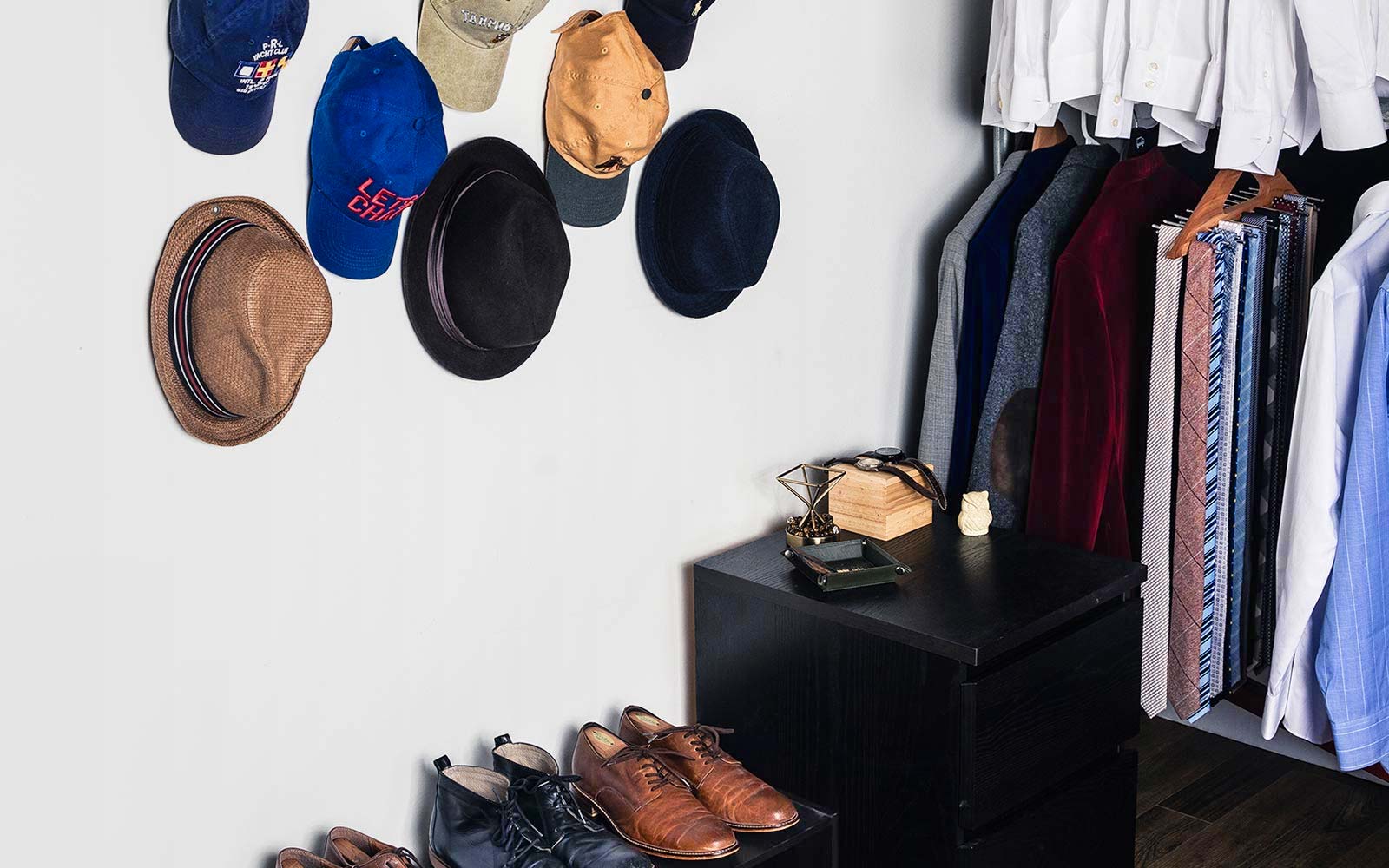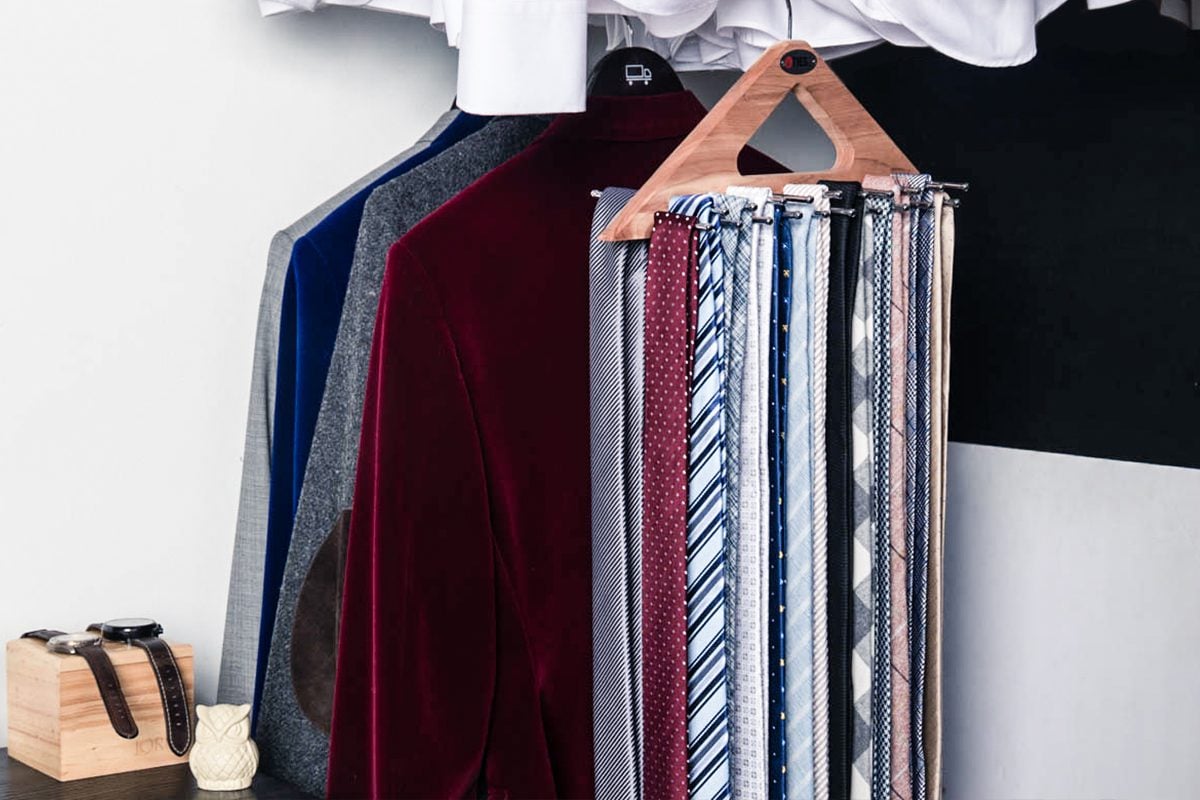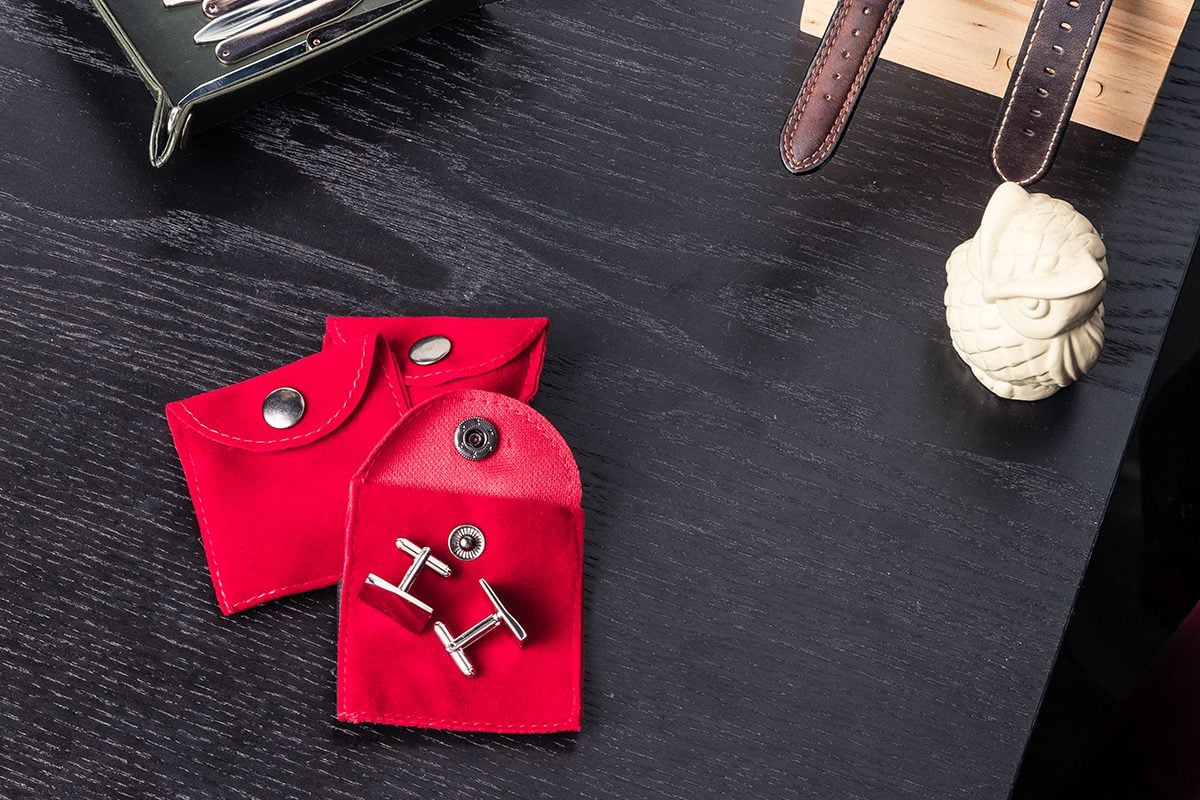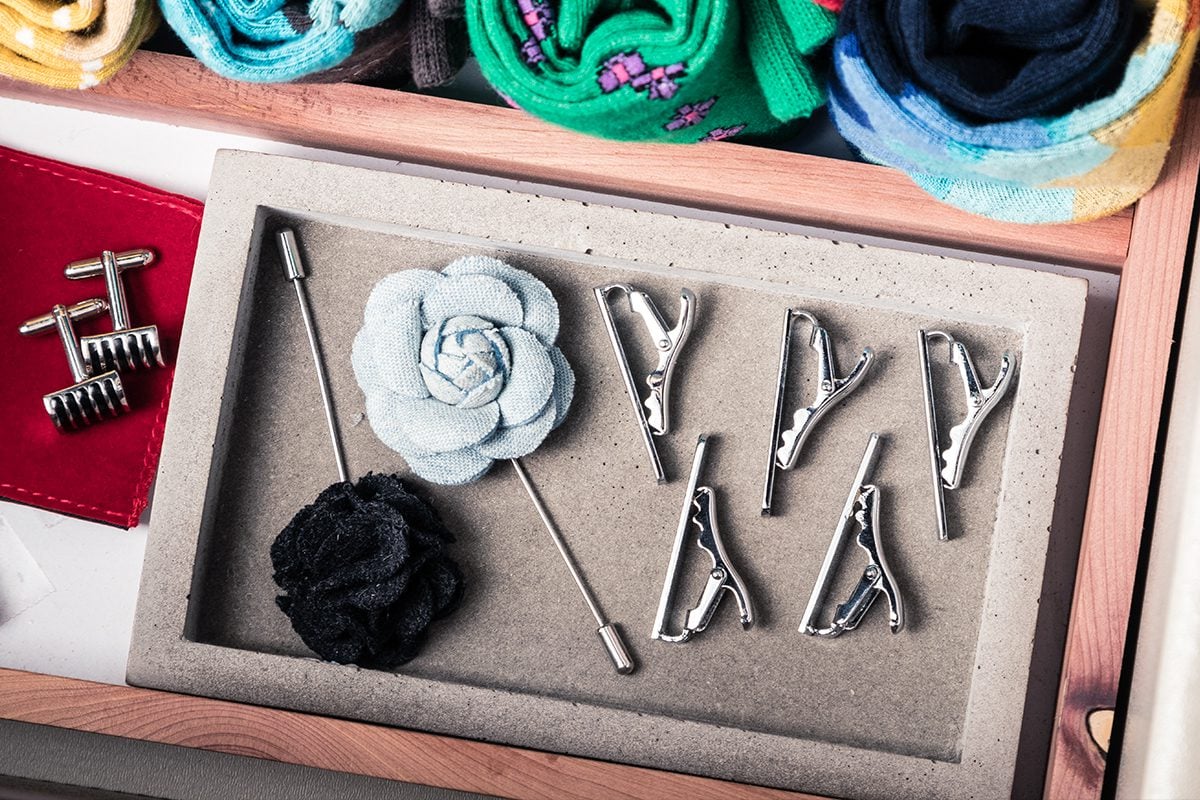How to Organize Your Accessories
With an organized closet, you'll actually wear more of the things you own

Written by RJ Firchau
You’ve spent a fair amount of time curating the pieces that comprise your style. You have all of the best ties, the nicest shoes, and the most eye-catching socks. In fact, you’ve got all the accessories you could possibly want to master your style. Awesome. But how do you organize all of them, especially since most of your accessories are small, delicate, or oddly shaped (we’re looking at you, cufflinks)? Nothing is worse than heading to your closet to get dressed for the day, only to be greeted by a tangled mess of fabric, metal, and leather. To set yourself up for an accessory collection that’s properly stored, clean, and easy to maintain, you’re going to need some organization savvy. Read on for tips on how to properly organize and store all of your favorite accessories so you can easily access them and keep them looking their best.
Necktie Storage

There are only a few acceptable ways to store a tie that will get the longest mileage out of it. Since most ties are made of delicate fabric, any other method of tie storage (folding, crumpling in a drawer, hanging on a hanger with the knot still done up, etc.) will create permanent creases in your tie or cause it to lose its shape.
The first and most highly recommended way is to hang your ties on a tie rack. If you don’t already own one, invest in a simple variation (you can find a good one in the $5 – $20 range, easy) that fits your closet space. If you have a dresser in your closet, you can buy a tie rack that stands on its own. Or, if the space in your closet is lacking, you could opt for a tie rack that mounts to your wall or that hangs like a hanger. Hanging your ties (after taking the knot out, of course) helps to loosen any creases and folds you may have created throughout the day by letting gravity do the work. The only exception to this rule is if you have any knitted ties. Knit ties should be rolled instead of hung, as hanging them could cause their knitted shape to stretch out.
That brings us to the second acceptable method of storing your ties: rolling. You can roll your ties loosely and place them in a box, a designated drawer, or a tray specifically made for this purpose. If you don’t have a tray, you could also get a compartmentalizing organizer for one of your drawers to store all of your rolled ties.
Pocket Squares Storage

You’d think that pocket square storage would be a no-brainer, but it’s still a little baffling to figure out what to do with small square pieces of fabric, especially when you’ve got several. If you only have a few squares in your possession, we suggest folding them up and placing one in each of your jacket pockets. That way, whenever you grab a jacket from your closet, you’ll already be accessorized! You could also keep a handful of pocket squares in a small box (like a cigar box) on your dresser. If you have a decent collection of pocket squares, consider folding them in half twice and stacking them on your dresser. Or, if you have a ton of squares, try folding them in half twice and stacking them on their side in one of your drawers, so that you can see all of them at once.
Cufflink Storage

If you only have a handful of cufflinks that you bust out on rare occasions, repurposing a fabric pouch (or buying one) and keeping them in that should do the trick. You could also keep each pair of cufflinks in an individual fabric pouch and keep all of them in one larger bag, for even better organization.
Alternatively, if you own cufflinks that are more expensive and that shouldn’t be stored loosely, you might want to consider investing in a storage box specifically for them, like this.
Collar Stays

You should treat your collar stays like you do the rest of your accessories, and remove them at the end of the day (so you don’t forget about them until after you take your laundry out and realize all of your stays are bent or broken). To store them, a drawstring pouch or small box (like a matchbox or old tie bar box) should do the trick. Alternatively, if you only have a few, a valet tray will also suffice.
Sock Storage

For most of us, organizing our sock drawers is an afterthought. If your drawer if filled to the brim with haphazardly thrown-in, mismatched socks, you’re going to need to pull them all out, match them up with their significant other (tossing out any stray or damaged/torn socks), and start fresh. There are two proper ways for storing your socks, but let’s first talk about what you shouldn’t be doing. If you pair your socks and then roll over one of the cuffs to “hold” the other together before throwing them into your drawer, stop. This practice, though well-intentioned, will eventually stretch out your cuffs and ruin the elasticity of your socks (and there’s nothing worse than putting on your favorite pair of dress socks and having them slide down your ankle while you’re running to work).
The first method of properly storing your socks takes the same idea as the cuff fold but uses the toe end of your socks instead. Simply create a “pocket” with one sock starting at the toe by rolling the fabric over itself, then stuff the toe end of the other sock into the pocket, and keep rolling until they are secure (halfway should do it, but you could roll the whole sock into the other if your heart desires).
The second method is to simply line up your socks and roll them, much like you would your ties. You can store these on their side in your sock drawer so you can easily see all of the socks you own at once. If you want to get even more organized, you could arrange your socks so that the everyday pairs are in the front of your drawer and the more novelty or seasonal pairs are in the back.
Tie Bars and Lapel Pins

Your tie bars should, first and foremost, not be stored on your ties when not in use (but you knew that, right?). Instead, organize them by keeping them in the boxes they came in, or by keeping them in a box or a valet tray in or on your dresser. We like to keep our lapel pins in valet trays or pinned to the lapels of our jackets so they all come pre-accessorized right off the hanger.
Belt Storage

Our favorite way to store belts is by rolling them up and placing them in a drawer, out of sight. If you have a ton of belts though, a belt rack will also suffice.
Hat Storage

You could stack your hats on your dresser, or if you have the wall space, install some hooks or Command strips to your wall and hang your hats up. Not only will this keep your hats in good shape, it’s also a cool way to display your collection both for yourself and for others.
Shoe Storage

As far as shoes are concerned, the best way to store them is in a way that’ll allow you to see them. So, while storing them in the boxes they came in might keep them as safe as possible, you might be less inclined to wear your entire shoe collection if you can’t see what’s available at any given time. A happy medium that keeps your shoes safe and lets you take a look at all of your options would be a shoe rack. Shoe racks range in all sizes and styles, so you can choose one that best fits your needs. And, if floor space is an issue, you can always opt for a hanging shoe rack or an over-the-door variation instead. When storing your expensive dress shoes, you should also consider using shoe trees to help them retain their shape. A nice pair of cedar shoe trees will keep your shoes in mint condition, with the added benefit of also minimizing odors that may accumulate after a long day’s wear.
Watches

The best way to store your watches is with a standard watch box or cigar box. Obviously, if you only own one or two, you should be fine storing them directly on your dresser or valet tray. However, if your collection is more extensive, a watch box is the way to go. Storing your watches separately from one another, like a watch box allows you to do, helps prevent your timepieces from friction, scratches, and other issues that could arise from overly cramped storage.
Bracelets

If you only own one or two bracelets, storing them on your valet tray should be good enough. However, if you own several, we suggest getting a cool piece of home decor, like a statue for your desk or a wooden jewelry organizer, and hanging your bracelets off of it.
RJ Firchau

Written by RJ Firchau
You’ve spent a fair amount of time curating the pieces that comprise your style. You have all of the best ties, the nicest shoes, and the most eye-catching socks. In fact, you’ve got all the accessories you could possibly want to master your style. Awesome. But how do you organize all of them, especially since most of your accessories are small, delicate, or oddly shaped (we’re looking at you, cufflinks)? Nothing is worse than heading to your closet to get dressed for the day, only to be greeted by a tangled mess of fabric, metal, and leather. To set yourself up for an accessory collection that’s properly stored, clean, and easy to maintain, you’re going to need some organization savvy. Read on for tips on how to properly organize and store all of your favorite accessories so you can easily access them and keep them looking their best.
Necktie Storage

There are only a few acceptable ways to store a tie that will get the longest mileage out of it. Since most ties are made of delicate fabric, any other method of tie storage (folding, crumpling in a drawer, hanging on a hanger with the knot still done up, etc.) will create permanent creases in your tie or cause it to lose its shape.
The first and most highly recommended way is to hang your ties on a tie rack. If you don’t already own one, invest in a simple variation (you can find a good one in the $5 – $20 range, easy) that fits your closet space. If you have a dresser in your closet, you can buy a tie rack that stands on its own. Or, if the space in your closet is lacking, you could opt for a tie rack that mounts to your wall or that hangs like a hanger. Hanging your ties (after taking the knot out, of course) helps to loosen any creases and folds you may have created throughout the day by letting gravity do the work. The only exception to this rule is if you have any knitted ties. Knit ties should be rolled instead of hung, as hanging them could cause their knitted shape to stretch out.
That brings us to the second acceptable method of storing your ties: rolling. You can roll your ties loosely and place them in a box, a designated drawer, or a tray specifically made for this purpose. If you don’t have a tray, you could also get a compartmentalizing organizer for one of your drawers to store all of your rolled ties.
Pocket Squares Storage

You’d think that pocket square storage would be a no-brainer, but it’s still a little baffling to figure out what to do with small square pieces of fabric, especially when you’ve got several. If you only have a few squares in your possession, we suggest folding them up and placing one in each of your jacket pockets. That way, whenever you grab a jacket from your closet, you’ll already be accessorized! You could also keep a handful of pocket squares in a small box (like a cigar box) on your dresser. If you have a decent collection of pocket squares, consider folding them in half twice and stacking them on your dresser. Or, if you have a ton of squares, try folding them in half twice and stacking them on their side in one of your drawers, so that you can see all of them at once.
Cufflink Storage

If you only have a handful of cufflinks that you bust out on rare occasions, repurposing a fabric pouch (or buying one) and keeping them in that should do the trick. You could also keep each pair of cufflinks in an individual fabric pouch and keep all of them in one larger bag, for even better organization.
Alternatively, if you own cufflinks that are more expensive and that shouldn’t be stored loosely, you might want to consider investing in a storage box specifically for them, like this.
Collar Stays

You should treat your collar stays like you do the rest of your accessories, and remove them at the end of the day (so you don’t forget about them until after you take your laundry out and realize all of your stays are bent or broken). To store them, a drawstring pouch or small box (like a matchbox or old tie bar box) should do the trick. Alternatively, if you only have a few, a valet tray will also suffice.
Sock Storage

For most of us, organizing our sock drawers is an afterthought. If your drawer if filled to the brim with haphazardly thrown-in, mismatched socks, you’re going to need to pull them all out, match them up with their significant other (tossing out any stray or damaged/torn socks), and start fresh. There are two proper ways for storing your socks, but let’s first talk about what you shouldn’t be doing. If you pair your socks and then roll over one of the cuffs to “hold” the other together before throwing them into your drawer, stop. This practice, though well-intentioned, will eventually stretch out your cuffs and ruin the elasticity of your socks (and there’s nothing worse than putting on your favorite pair of dress socks and having them slide down your ankle while you’re running to work).
The first method of properly storing your socks takes the same idea as the cuff fold but uses the toe end of your socks instead. Simply create a “pocket” with one sock starting at the toe by rolling the fabric over itself, then stuff the toe end of the other sock into the pocket, and keep rolling until they are secure (halfway should do it, but you could roll the whole sock into the other if your heart desires).
The second method is to simply line up your socks and roll them, much like you would your ties. You can store these on their side in your sock drawer so you can easily see all of the socks you own at once. If you want to get even more organized, you could arrange your socks so that the everyday pairs are in the front of your drawer and the more novelty or seasonal pairs are in the back.
Tie Bars and Lapel Pins

Your tie bars should, first and foremost, not be stored on your ties when not in use (but you knew that, right?). Instead, organize them by keeping them in the boxes they came in, or by keeping them in a box or a valet tray in or on your dresser. We like to keep our lapel pins in valet trays or pinned to the lapels of our jackets so they all come pre-accessorized right off the hanger.
Belt Storage

Our favorite way to store belts is by rolling them up and placing them in a drawer, out of sight. If you have a ton of belts though, a belt rack will also suffice.
Hat Storage

You could stack your hats on your dresser, or if you have the wall space, install some hooks or Command strips to your wall and hang your hats up. Not only will this keep your hats in good shape, it’s also a cool way to display your collection both for yourself and for others.
Shoe Storage

As far as shoes are concerned, the best way to store them is in a way that’ll allow you to see them. So, while storing them in the boxes they came in might keep them as safe as possible, you might be less inclined to wear your entire shoe collection if you can’t see what’s available at any given time. A happy medium that keeps your shoes safe and lets you take a look at all of your options would be a shoe rack. Shoe racks range in all sizes and styles, so you can choose one that best fits your needs. And, if floor space is an issue, you can always opt for a hanging shoe rack or an over-the-door variation instead. When storing your expensive dress shoes, you should also consider using shoe trees to help them retain their shape. A nice pair of cedar shoe trees will keep your shoes in mint condition, with the added benefit of also minimizing odors that may accumulate after a long day’s wear.
Watches

The best way to store your watches is with a standard watch box or cigar box. Obviously, if you only own one or two, you should be fine storing them directly on your dresser or valet tray. However, if your collection is more extensive, a watch box is the way to go. Storing your watches separately from one another, like a watch box allows you to do, helps prevent your timepieces from friction, scratches, and other issues that could arise from overly cramped storage.
Bracelets

If you only own one or two bracelets, storing them on your valet tray should be good enough. However, if you own several, we suggest getting a cool piece of home decor, like a statue for your desk or a wooden jewelry organizer, and hanging your bracelets off of it.
RJ Firchau
SOURCE: THE GENTLEMANUAL
Comments
Post a Comment